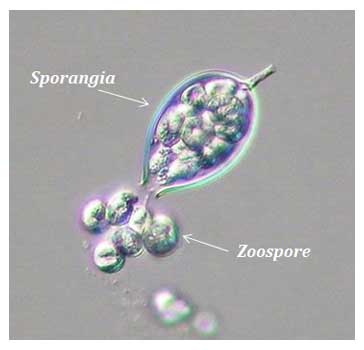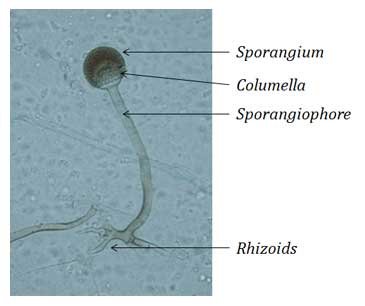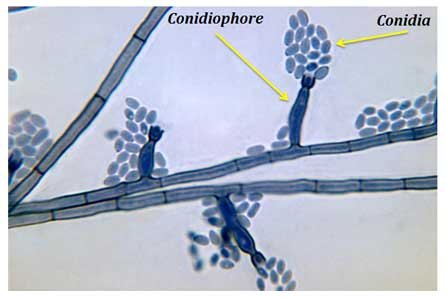Fungi reproduce by vegetative, asexual and sexual methods. This post describes the various types of Asexual Reproduction in Fungi. About 20% fungi propagate only by asexual means. Asexual reproduction take places during favorable condition by the formation of a variety of spores. Such spores produced by asexual reproduction are called mitospores. Spores may be unicellular (Aspergillus, Penicillium) or Multicellular (Alternaria, Cercospora)
Asexual Reproduction in Fungi
Ø Based on the number of cells in spores, asexual spores of fungi are classified into:
1. Amerospore: one celled spores
2. Didymospore: two celled spores
3. Phragmospore: spore with two or more transverse septa
4. Dictyospores: spores with one or more transverse and vertical septa
5. Scolecospores: vermiform or filiform (thread like) shaped spores
6. Staurospores: stellate or spores with radiating arms
7. Helicospores: spirally coiled spores
Ø The number of cells in spores have immense taxonomic importance for the identification and classification of fungi
Ø The spores may be endogenous when enveloped in pycnidia or sporangia (Mucor, Rhizopus) or they may be exogenous when developed on sporophores or conidiophores (Aspergillus, Penicillium)
Ø Spores produced in specialized sacks called sporangia are known as sporangiospores
Ø Spores produced on the tip of hyphae either singly or in group, is called conidiospores
Ø Common asexual spores of fungi are:
(1). Zoospores
(2). Aplanospores
(3). Conidiospores
(4). Chlamydospores
(5). Pycnidiospores
(6). Oidia

(1). Zoospores
Ø Zoospores are a type of sporangiospores (endospore)
Ø They are motile spores with flagella
Ø Zoospores are usually produced by lower groups of fungi
Ø Example: Phythium, Phytopthora
Ø Based on the number and position of flagella, there are three types of zoospores in fungi
(1). Posteriorly uni-flagellated zoospores: zoospores with posteriorly placed whiplash type of flagella (example: Chytridiomycetes)
(2). Anteriorly uni-flagellated zoospore: zoospores with anteriorly placed tinsel type of flagella (Example: Hypochytridiomycetes)
(3). Biflagellated zoospores: zoospores with two anteriorly or laterally attached flagella, one is whiplash and the other is tinsel type (Example: Oomycetes)

Rhizopus (source wikipedia)
(2). Aplanosores
Ø Aplanospores are non-motile spores, produced in sporangia (endospores)
Ø Usually they are round in shape with one or many nucleus
Ø Most of the cases, aplanospores are produced in large numbers
Ø They can germinate by the formation of germ tube in the favourable conditions
(3). Conidia or conidiospores
Ø Conidia are non-motile spores
Ø They are produced in single or in chain on special type of hyphae called conidiophore
Ø Conidia are exospores since they are produced exogenously

Conidiophore with conidia (source wikipedia)
(4). Pycnidiospores
Ø They are very small spores produced in special structures called Pycnidia
Ø Pycnidiospors are usually produced by members of fungi imperfectii (Deuteromycetes) and many lichens
Ø They are usually single celled, thin walled, however multicellular pycnidiospres are also found
(5). Chlamydospores
Ø Chlamydospores are thick walled resting spores
Ø They store food materials (Eg. Ustilago)
(6). Oidia
Ø Hyphae breaks up to small pieces each develops into single called oidia
Ø Oidia are generally thin walled and small
Ø They do not store food material
Ø Oidia germinate immediately after liberation (Eg. Coprinus)
Ø Fungal component in some lichen can reproduce by the formation of oidia
Learn more: Vegetative Reproduction in Fungi
Learn more: Sexual Reproduction in Fungi
| You may also like... | ||
|---|---|---|
| NOTES | QUESTION BANK | COMPETITIVE EXAMS. |
| PPTs | UNIVERSITY EXAMS | DIFFERENCE BETWEEN.. |
| MCQs | PLUS ONE BIOLOGY | NEWS & JOBS |
| MOCK TESTS | PLUS TWO BIOLOGY | PRACTICAL |
You may also like…
